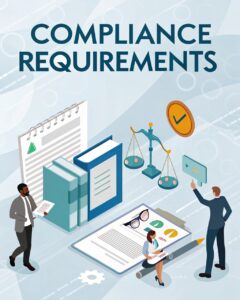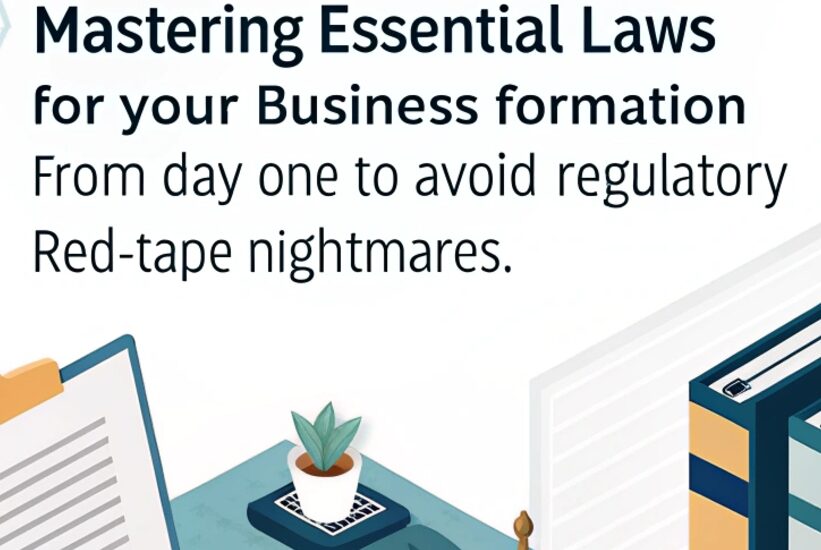Are you tired of feeling stuck in a never-ending cycle of compliance headaches and regulatory nightmares?
As an entrepreneur, exploring the complex landscape of business regulations can be overwhelming. From tax laws to employment standards, it’s easy to get lost in the weeds.
But what if you could break free from that cycle and focus on growing your business without worrying about compliance? That’s exactly what we’ll explore today – a roadmap for avoiding regulatory red-tape headaches and setting yourself up for long-term success.
Setting Up for Success
To master essential laws for your business formation, it’s crucial to set up a strong foundation from day one. This means being familiar with key regulations that govern your industry and creating systems to stay compliant.
When first starting out, most businesses find themselves entangled in a web of red-tape regulations. To avoid this situation, take the time to understand the basics of business formation laws and regulatory requirements specific to your sector.
This may include registering for necessary licenses or permits, filing annual reports with relevant authorities, and adhering to industry-specific standards. By keeping track of these obligations from day one, you can ensure that everything runs smoothly as your business grows.
Develop a compliance mindset by establishing clear processes for staying on top of regulatory changes and updates. This may involve setting up regular check-ins with legal counsel or registering for alerts from government agencies.
By prioritizing compliance, you’ll be able to explore the complex landscape of regulations and avoid costly mistakes that can hinder growth.
The Importance of Being Prepared – Knowing Your Business Structure Options
Avoid getting caught off guard by regulatory red-tape nightmares—learn how to choose the right business structure from day one. Did you know that 1 in 5 small businesses fail due to poor business planning? Ensure your business structure is set up for success with our Gulf business setup services.
When it comes to starting a new business, having an unclear or poorly planned business structure can lead to regulatory red-tape nightmares. As an entrepreneur, it’s easy to get caught up in the excitement of launching your venture and overlook the importance of setting up shop for success. But neglecting this crucial step can lead to financial strain, lost productivity, and even personal liability. Discover how we simplify business setup in Gulf countries to help entrepreneurs avoid these pitfalls.
Before we dive into the different types of business structures available, let’s consider a common pain point many entrepreneurs face: choosing between Sole Proprietorship, Partnership, Incorporation, Limited Liability Company (LLC), or Limited Liability Partnership (LLP). Each option has its pros and cons. Learn more about which business structure suits your goals in Gulf countries with our expert guidance:
**Sole Proprietorship
As a sole proprietorship is business owned by just one person, this might seem appealing for those who want to start small. However, consider these key factors before making the leap:
- You’re personally liable for all debts and obligations of your company.
- Lack of separation between personal and professional finances can lead to tax complications.
**Partnership
Partnering up with two or more people allows you to share profits and losses equally, but be aware of:
- Shared decision-making can become challenging when conflicts arise.
- Inadequate agreements can lead to disputes over ownership and control.
**Corporation
Corporations offer liability protection but come with tax implications that may increase in some cases. Keep in mind:
- Double taxation: the corporate level and personal level (e.g., self-employment taxes).
- Increased compliance requirements, which might deter small businesses from adopting this structure.
**Limited Liability Company (LLC)
An LLC provides similar liability protections as corporations while maintaining the flexibility of a partnership structure. Consider these benefits when weighing an LLC:
- Flexible tax treatment and pass-through taxation.
- Potential for scalability without sacrificing control or separation between personal assets.
**Limited Liability Partnership (LLP)
Combining elements of both partnerships and corporations, LLPs offer liability protection to its members while allowing them to share ownership. Be aware of these potential drawbacks:
- Ownership stakes can be diluted if not managed properly.
- Partner disagreements may arise from unequal distribution of profits or decision-making power.
Before making a final decision, take the following red flags into consideration:
Red Flags: What to Avoid When Choosing a Business Structure
Don’t fall for common pitfalls like misinterpreting liability protection as an illusion. Some key mistakes include:
- Confusing tax treatment with business structure.
- Failing to update your documents and contracts.
Not accounting for potential risks in the future.
By being aware of these red flags, you can create a solid business foundation that minimizes risk. This means taking the time to research each option carefully before making an informed decision.
Exploring Complex Regulations and Red Tape
Exploring complex regulations and red tape can be a nightmare, but it doesn’t have to be. According to the Small Business Administration (SBA), over 75% of businesses fail due to regulatory issues. It’s time to take control of your business’s compliance.
In this article, we’ll break down essential laws and regulations that every business must understand from day one. By doing so, you’ll avoid costly fines, reputational damage, and the stress that comes with non-compliance.
**Business Structure 101: Choosing the Right Framework
When forming a business structure, it’s easy to get overwhelmed by the numerous options. Here are three key structures to consider:
* Sole Proprietorship
* Partnership
* Limited Liability Company (LLC)
Each structure has its unique set of rules and regulations that must be followed for compliance.

**Corporate Structures: What You Need to Know
A sole proprietorship is owned and controlled by one individual, while a partnership involves multiple owners. An LLC, on the other hand, offers liability protection but requires more formalities.
* Sole Proprietorships:
* Registration requirements
* Tax implications
<!—->
* Partnerships:
* Partnership agreements
* Profit-sharing structures
<!—->
* Limited Liability Companies (LLCs):
+ Operating agreements
– Company governance
**Compliance is Key: Why Bother?
Many laws are designed to protect consumers and promote fairness. But when it comes down to exploring complex regulations, you’ll often find yourself caught between compliance with the letter of the law versus innovation and growth.
Business owners who fail to prioritize compliance risk facing:
* Fines
* Loss of business licenses
– Reputational damage
<!—->
By understanding these essential laws and regulations from day one, you can avoid regulatory red-tape nightmares down the line. It’s time to take control of your business’s compliance.
Understanding Intellectual Property Law in the Digital Age
As your business takes off, intellectual property law can be overwhelming, but understanding its basics is crucial. Without a solid grasp of IP laws, your creation will be exposed to theft and misappropriation.
Patents are like digital locks that protect innovative products or services from being copied without permission. Think of software development: if you create an app with AI-driven technology, patenting it can safeguard against others who might claim they came up with the idea first. In reality, companies like Uber and Airbnb have successfully used patents to defend their core innovations.
Trade marks are more than just logos; they also include sounds, smells, and even color schemes! The iconic Nike swoosh symbol is a famous example of this. When properly registered, trade marks prevent counterfeiting and unauthorized use. Take Apple’s story – the company fought for years to protect its design patents against knockoff products.
To start protecting your business:
* Research patent categories that apply to you (e.g., software or medical devices).
* Learn how common trade mark infringements can cost businesses millions of dollars in lost revenue.
* Start building a strong brand identity with unique logos, sounds, and designs.
Real-world companies have profited from IP laws by preventing copycats. For instance:
A renowned fashion designer created a fragrance that became an instant bestseller; however, they registered it to safeguard against unauthorized reproduction.
In the tech world, Amazon successfully used patents for their drone delivery systems without being copied.
Avoid being caught off guard and protect your business today with these actionable steps!
By following these simple tips and taking concrete actions towards IP law education, you’ll create original work that can withstand copycats. Remember: a strong grasp of intellectual property laws is key to securing financial success in the market.
Disputing a Non-Compete Clause with a Lawyer
A non-compete clause can be a business owner’s worst nightmare: it stifles growth, limits strategy, and puts profits at risk. For instance, imagine Google co-founder Larry Page left his job to start AdWords only to have a contract modified with an overly restrictive clause that could limit him from taking on new projects.
A lawyer is crucial in exploring these situations and finding ways to mitigate risks. If you suspect a non-compete clause might be unfair or overly restrictive, consulting with an attorney can help identify the best course of action. For example, if you’re considering hiring someone from your former company as part of your new business team – but that person has signed a contract containing a non-compete clause that prohibits them from working for competitors.
In some cases, disputing a non-compete clause is possible if it violates your rights as an entrepreneur. Think California courts’ recent rulings on restrictive non-competes in the tech industry: those found to be unfair because they limit access to job opportunities or economic growth. A case that comes close to this concept was in 2019, when a jury ruled against *Amazon* after finding their contract limiting one of its employees from working for rival companies after leaving violated employment law.
By understanding the laws and regulations surrounding non-compete clauses, you can make informed decisions about what’s best for your business. For instance, if an entrepreneur finds themselves in this predicament with a new company looking to poach talent that has signed on restrictive contracts – there are potential solutions available.
Compliance for Startups and Small Businesses
Non-compliance can be devastating for your business – costly fines, reputational damage, and even closure. The stakes are high: non-compliance can result in significant financial penalties and a damaged reputation.
To master the essential laws from day one and avoid regulatory red-tape nightmares, focus on building compliance into your company’s DNA. This means embedding a culture of compliance within your organization.
Here are some key considerations:
**Understanding Industry-Specific Regulations: In food handling establishments, failing to follow proper guidelines can lead to devastating consequences. The FDA requires food handlers to pass an HACCP training program and maintain accurate records of employee training hours and sanitation procedures. Failure to do so can result in costly fines and even closure.
For healthcare providers, HIPAA regulations come into play. Non-compliance with these standards can result in serious data breaches, putting patient information at risk. For example, the 2013 breach involving Anthem Health Management resulted in over $16 million in penalties for not implementing adequate security measures to protect sensitive medical records.

**Familiarizing Yourself With Industry-Specific Laws and Regulations: Don’t assume that your business is exempt from certain regulations just because it’s a small operation. Healthcare providers must adhere to HIPAA, while food handling establishments are governed by the FDA. Researching these specific laws can help you stay ahead of potential compliance issues before they become major problems.
Some other industries with unique regulatory requirements include:
**Payment Card Industry Data Security Standard (PCI DSS): This standard requires companies that handle credit card transactions to implement robust security measures, including encryption and secure data storage. Failure to comply can result in fines ranging from $5,000 to $39,951 per incident.
To avoid these pitfalls, consider the following:
* Invest in industry-specific training programs
* Develop a comprehensive compliance framework with clear policies and procedures
* Establish a system for monitoring regulatory adherence
By taking proactive steps towards compliance, you can minimize risks and focus on what matters most – growing your business. This may involve creating an internal audit system to monitor regulatory requirements or establishing metrics to measure success.
Practical Strategies:
**Developing A Compliance Framework: Create clear policies, procedures, and job descriptions for roles such as a Compliance Officer or Auditor.
* Define measurable goals and objectives for compliance
* Develop a training program that includes interactive modules on regulatory updates and industry best practices
**Investing In Industry-Specific Training Programs: Look into certification programs like the Certified Information Systems Security Professional (CISSP) to ensure you have the necessary skills.
**Avoid Common Compliance Pitfalls:
Don’t skip this step: Create a comprehensive compliance program that includes regular audits, incident reporting, and employee training.
Don’t assume it’s someone else’s responsibility: Assign clear roles and responsibilities for ensuring regulatory compliance within your organization.
Managing Regulatory Changes – The Impact of Government Policies on Business
Regulatory red-tape is a business owner’s worst nightmare. It can stifle growth, erode profitability, and leave companies vulnerable to costly fines or even shutdowns.
The key to surviving regulatory changes lies in monitoring government announcements with as much attention as possible. Industry publications, news outlets, and official government websites are essential resources for staying informed about updates and revisions.
For example, the Affordable Care Act has a direct impact on small businesses. Employers must provide health coverage or face penalties – it’s not just a matter of tossing money at the problem with generic insurance solutions; HR specialists can help explore compliance issues related to employment law, ensuring your business doesn’t get caught off guard by changes in regulations.
To stay ahead of regulatory changes is like driving down a highway with speed limit signs all around. You must be aware and adapt quickly to avoid being penalized or held back by onerous rules and requirements – it’s time to treat regulatory compliance not as an afterthought, but as proactive surveillance that anticipates problems before they arise.
Companies can take the following steps to stay compliant:
Regularly review industry publications and official government websites for updates
Collaborate with other business owners or HR specialists to share knowledge on exploring regulations
Set up a hotline for reporting changes in real-time
Staying informed is key to adapting quickly, not reacting hastily.
How to Use Technology to Reduce Paperwork
Red tape can be overwhelming for new businesses, threatening to stall growth and profits with a sea of paperwork. Automation is your lifeline in exploring this complex regulatory landscape.
Automation helps tame the beast that is tax preparation by streamlining tasks like filling out forms and submitting reports. This not only saves you time but also reduces the risk of human error, a common pitfall when dealing with manual processes.
Cloud-based document storage solutions offer another significant advantage. For instance, Google Drive or Dropbox provide an online repository for storing your documents. By having these files accessible from any location with an internet connection, you can eliminate paper clutter in your office and foster greater collaboration among stakeholders by easily sharing documents and working on shared projects.
Security is also paramount when dealing with sensitive business information. Online document storage solutions like those mentioned earlier offer robust security features that include encryption methods and data backups. For example, Google Drive’s built-in two-factor authentication ensures an added layer of security for users accessing files stored within it.
Automation software such as accounting tools can significantly impact your workflow by automating financial record management tasks such as generating invoices from QuickBooks or Xero. One business case that exemplifies this is XYZ Inc., which successfully reduced the time spent on invoicing using these automation tools, allowing them to redirect resources toward more important aspects of their company.
Email marketing also plays a pivotal role in streamlining communication between businesses and clients without relying on physical paper records. The use of mass emails for business correspondence reduces lost documents and saves employees from hours spent searching through piles of paperwork.
Automation software like QuickBooks or Xero can automatically generate invoices, significantly reduce the time required to complete financial tasks, thus providing a substantial ROI by allowing more efficient processing.
By utilizing these automated tools and online collaboration platforms, businesses can make better use of their time to focus on growth.
Addressing Tax Obligations in Your State and Local Jurisdiction
Exploring tax obligations can be a daunting task for many entrepreneurs, especially when dealing with state and local regulations that seem complex and ever-changing.
The key to success lies in understanding your specific tax landscape. Here are some essential things to consider:
* Familiarize yourself with the unique tax laws in your area. For example:
+ In California, businesses must pay a minimum of $800 per year for each new hire, or risk being denied registration.
+ In New York City, sales taxes on certain goods exceed 8% – so you need to know exactly what is subject to this high rate.
* Each type of business has its own set of tax obligations and requirements. For instance:
+ Sole proprietorships are considered pass-through entities for income tax purposes in most states.
+ Corporations, however, are taxed on their profits at the corporate level before they’re distributed to shareholders – which can result in double taxation if not planned correctly.
Understanding what business is registered as a corporation or partnership (or sole prop) helps you explore tax implications better. It’s crucial for this step and has many benefits:
+ Reduces tax burden by avoiding excessive state income taxes on salaries.
+ Provides the possibility of obtaining liability protection in case something bad happens to your company.
To keep track of your business expenses throughout the year, use these tips:
* Make a record book that includes every transaction. This can be as simple as a spreadsheet or even an app like QuickBooks (for accounting purposes).
* Regularly go over receipts and invoices.
+ For instance, if you purchased new equipment in 2022 worth $5k for business operations, keep this on paper.
Researching the tax benefits available to your kind of industry can be life-saving:
+ Start-ups with less than a million dollars in annual revenue can qualify for lower corporate taxes (typically around 4%).
+ Businesses operating out of NYC can apply for reduced sales and property taxes under specific circumstances, making it essential that you’re aware.
Finally, stay informed about upcoming changes to tax laws so you don’t end up facing costly penalties:
+ Stay ahead of your competition.
* Tax law updates often occur quietly until a company has already gotten itself into trouble due to non-compliance (be careful!).
Mitigating Cybersecurity Risks with Data Privacy Laws
Protecting your company’s sensitive data is crucial. Non-compliance can result in significant fines and reputational damage, such as when a well-known retailer was fined $1 million for violating GDPR regulations.
To ensure you’re compliant, familiarize yourself with key regulations like GDPR or CCPA. This involves understanding what constitutes personally identifiable information (PII) and how to handle it properly. For instance, knowing that customers have the right to access their personal data is a crucial aspect of these regulations.
You must also implement robust security measures to prevent unauthorized access to your systems and data. This includes using encryption technology, secure password management tools like two-factor authentication methods. Regular system updates and vulnerability assessments can help strengthen your defenses against cyber threats.
Having an incident response plan in place for when cyber attacks happen is vital too. To be effective, it should outline steps such as containing the breach within hours (e.g., alerting authorities, securing affected systems), removing affected data immediately, and notifying all relevant parties.
For instance, when a company experiences a massive data breach like Equifax last year which resulted in over 147 million records being stolen due to lax security measures.
Key points for your business to consider:
* Make sure you’re complying with specific regulations such as GDPR or CCPA.
* Use strong security protocols and tools like firewalls, intrusion detection systems, and encryption methods.
Understanding the Role of Insurance Coverage for Small Businesses
Great businesses don’t let regulatory red-tape nightmares hold them back. By understanding how insurance coverage can help, they’re able to stay compliant and focus on growth.
The right insurance coverage is essential for small businesses as it protects against unexpected events that could derail operations or even lead to financial disaster. Without adequate protection, a business may struggle financially when faced with unforeseen circumstances such as accidents, natural disasters, or cyber attacks.
By having the right insurance coverage in place from day one, businesses can avoid costly delays and penalties for non-compliance. This ensures they’re always operating within the bounds of regulations.
Take proactive action today to ensure your small business has the insurance coverage it needs to thrive without worrying about regulatory hurdles that could stifle its growth. By doing so, you’ll be better equipped to handle unexpected setbacks and keep moving forward with confidence.

